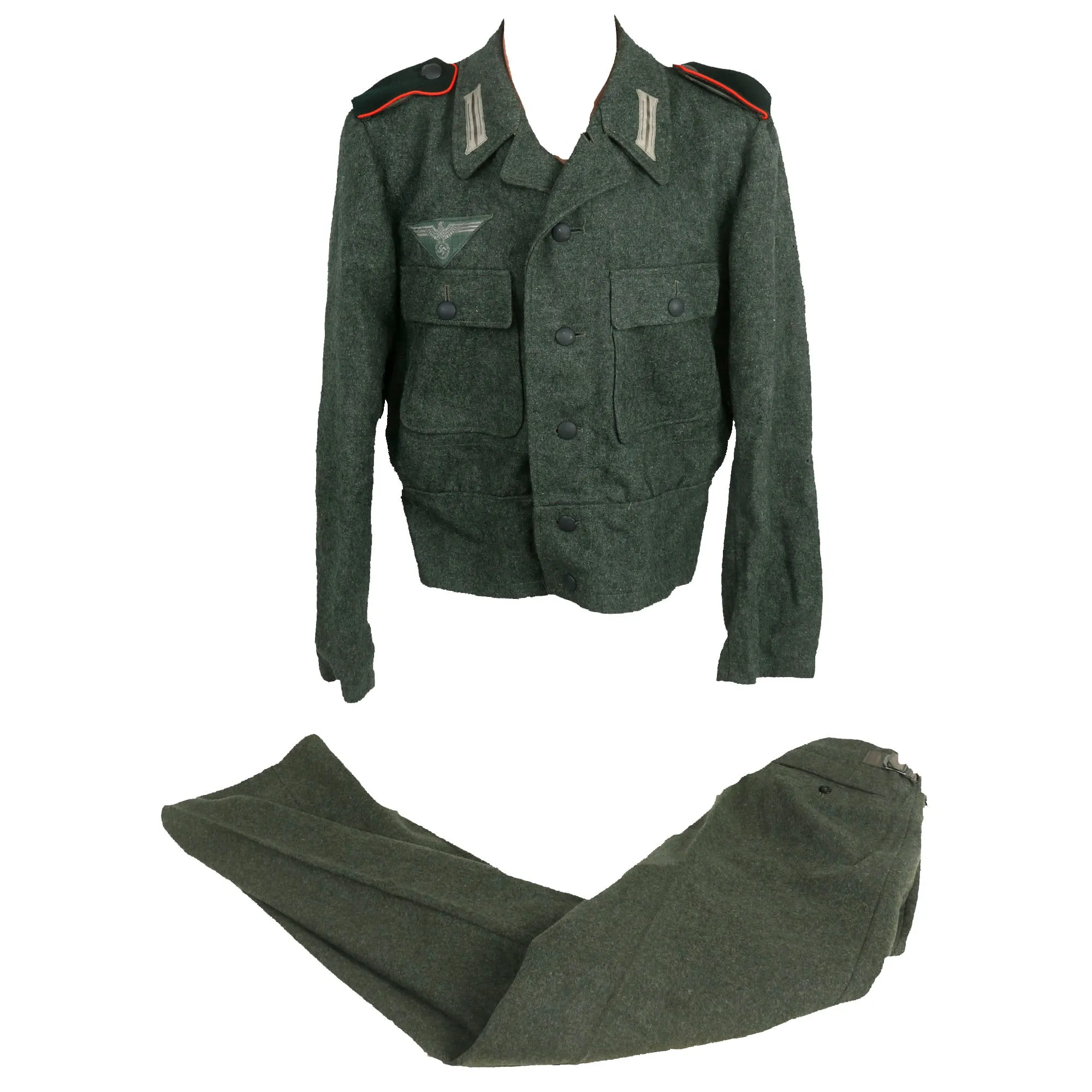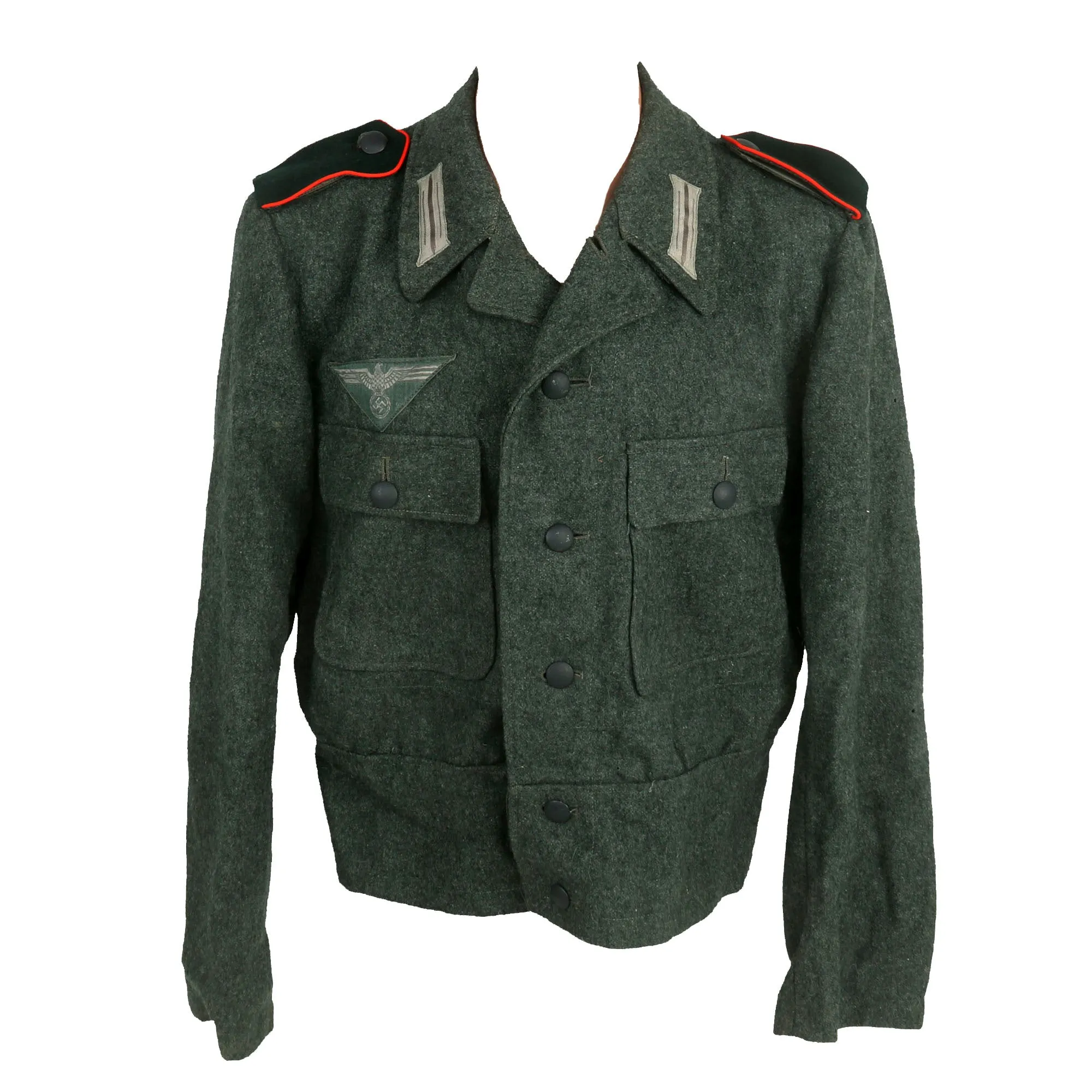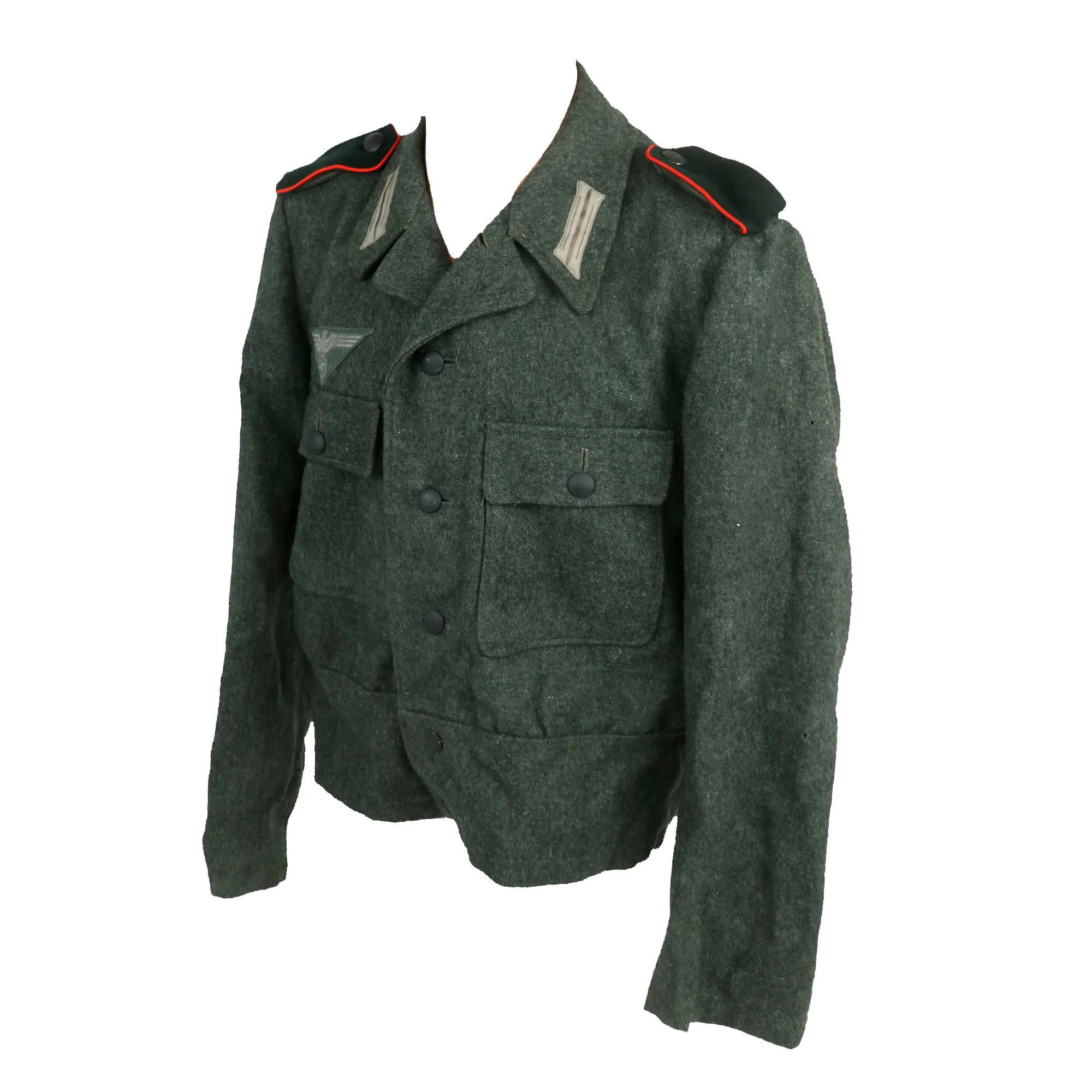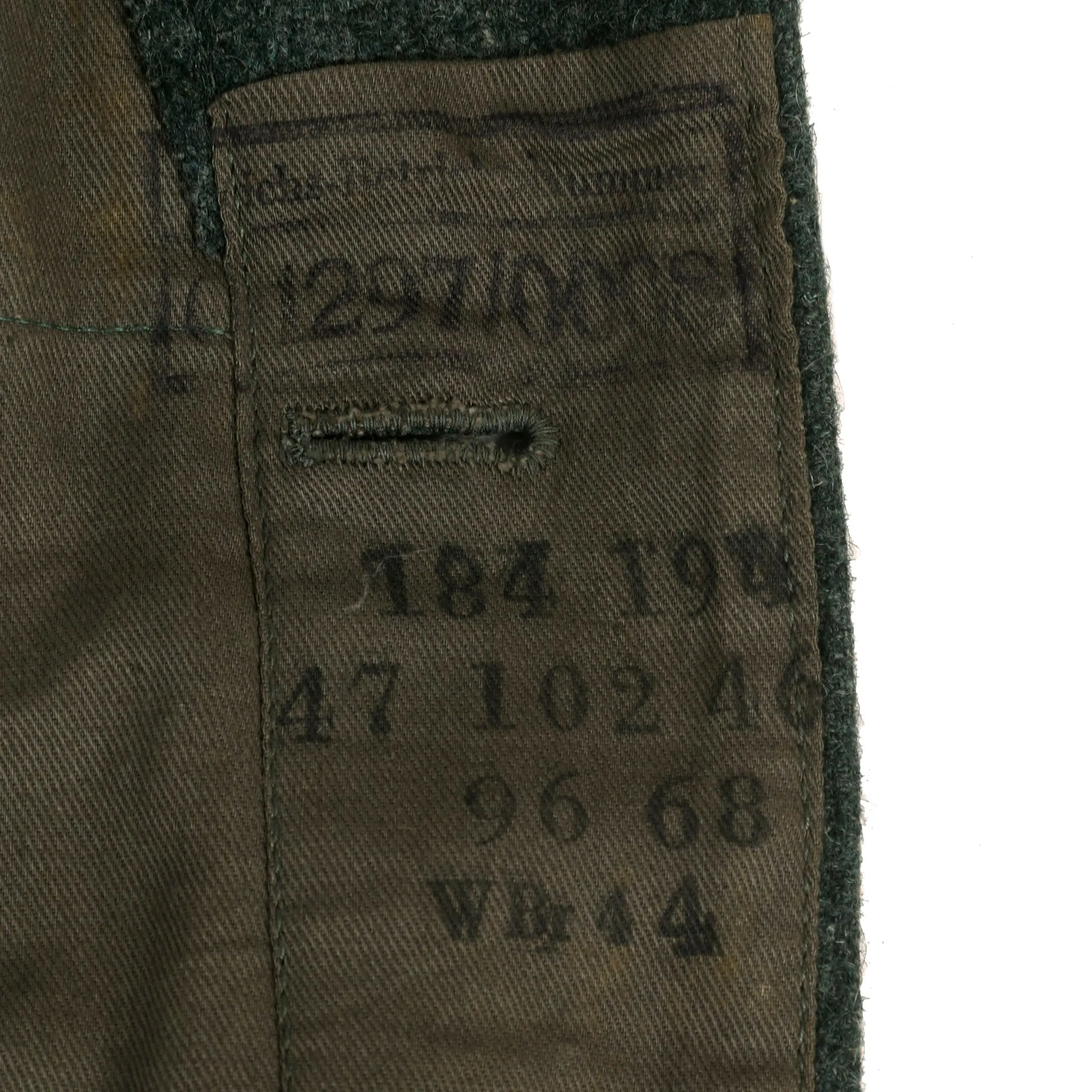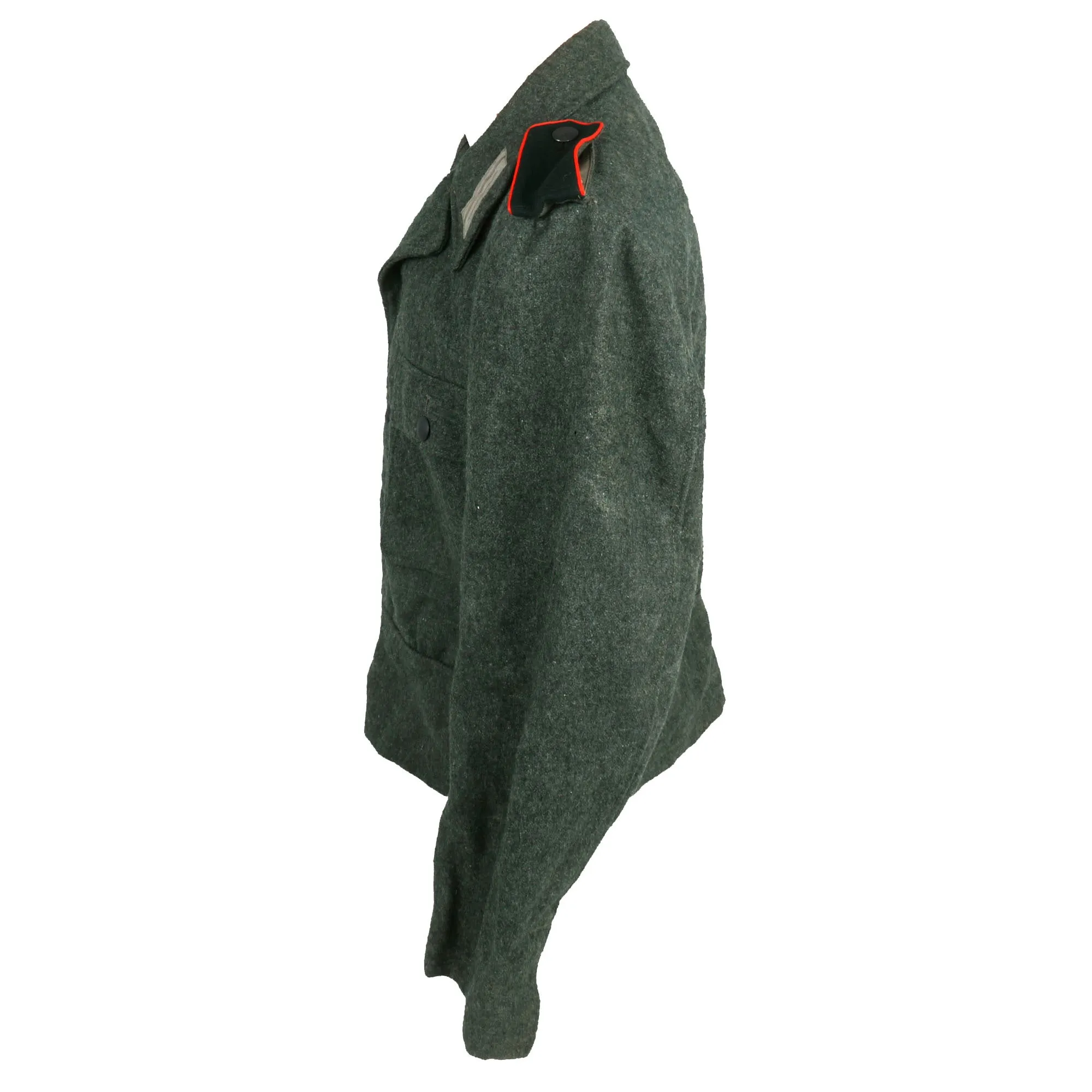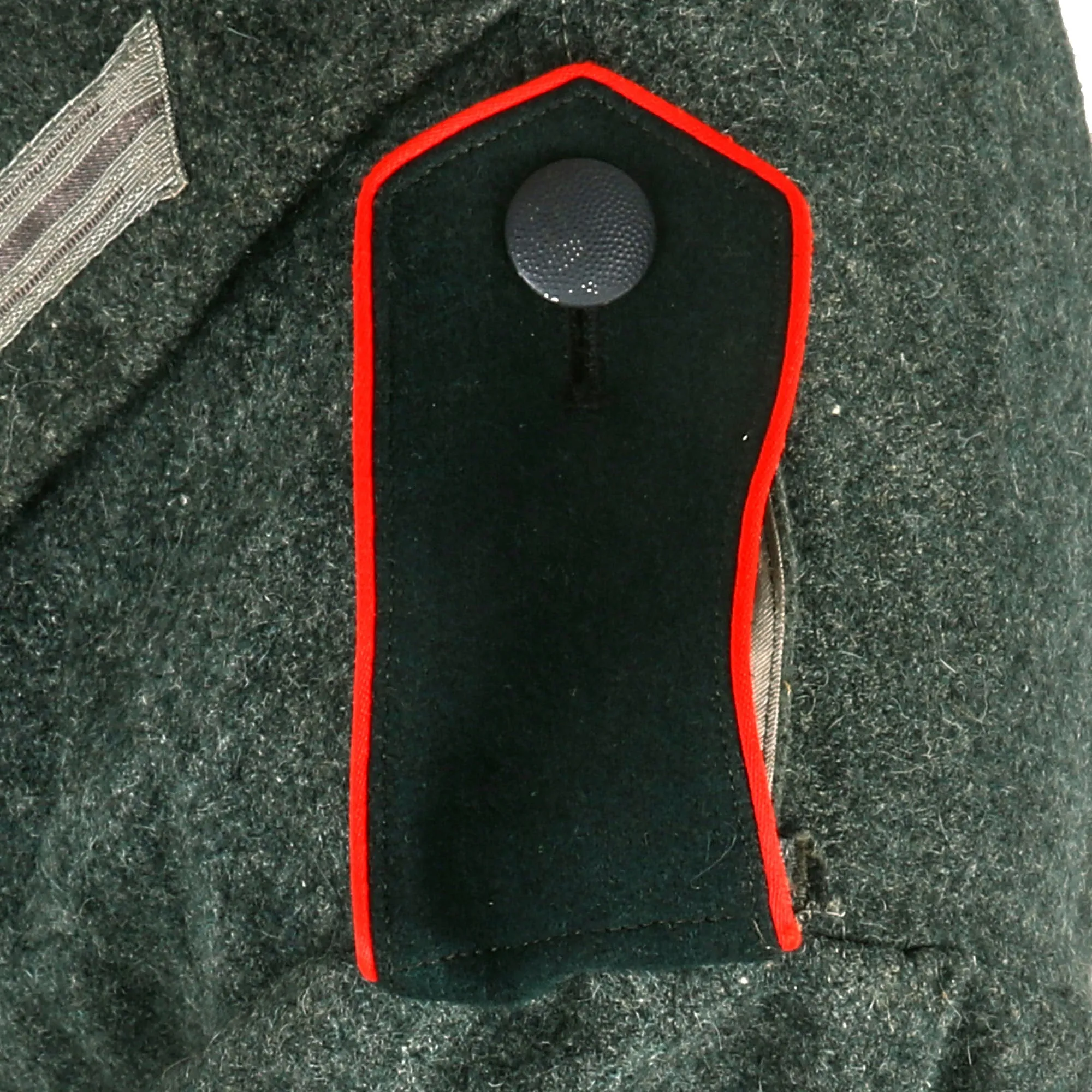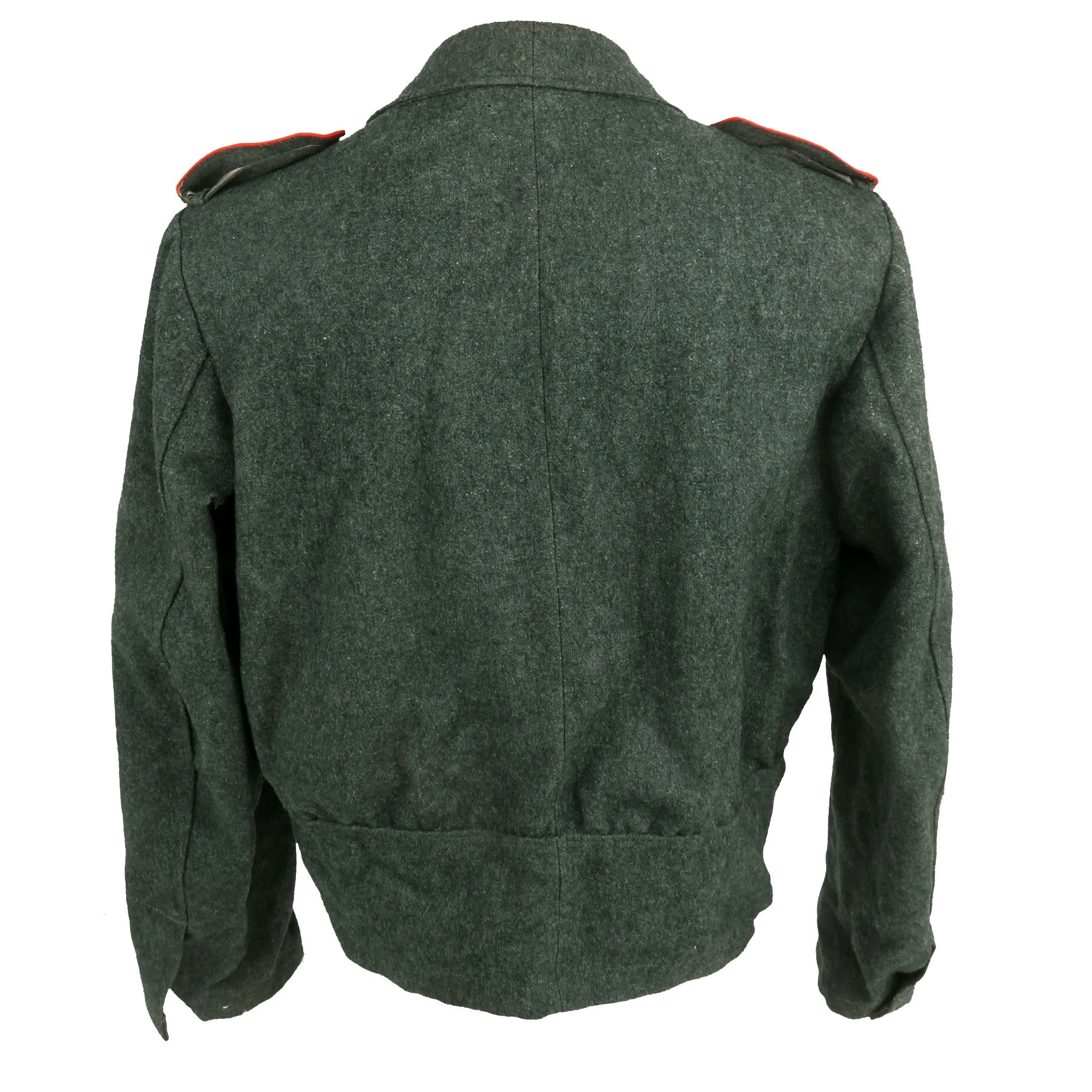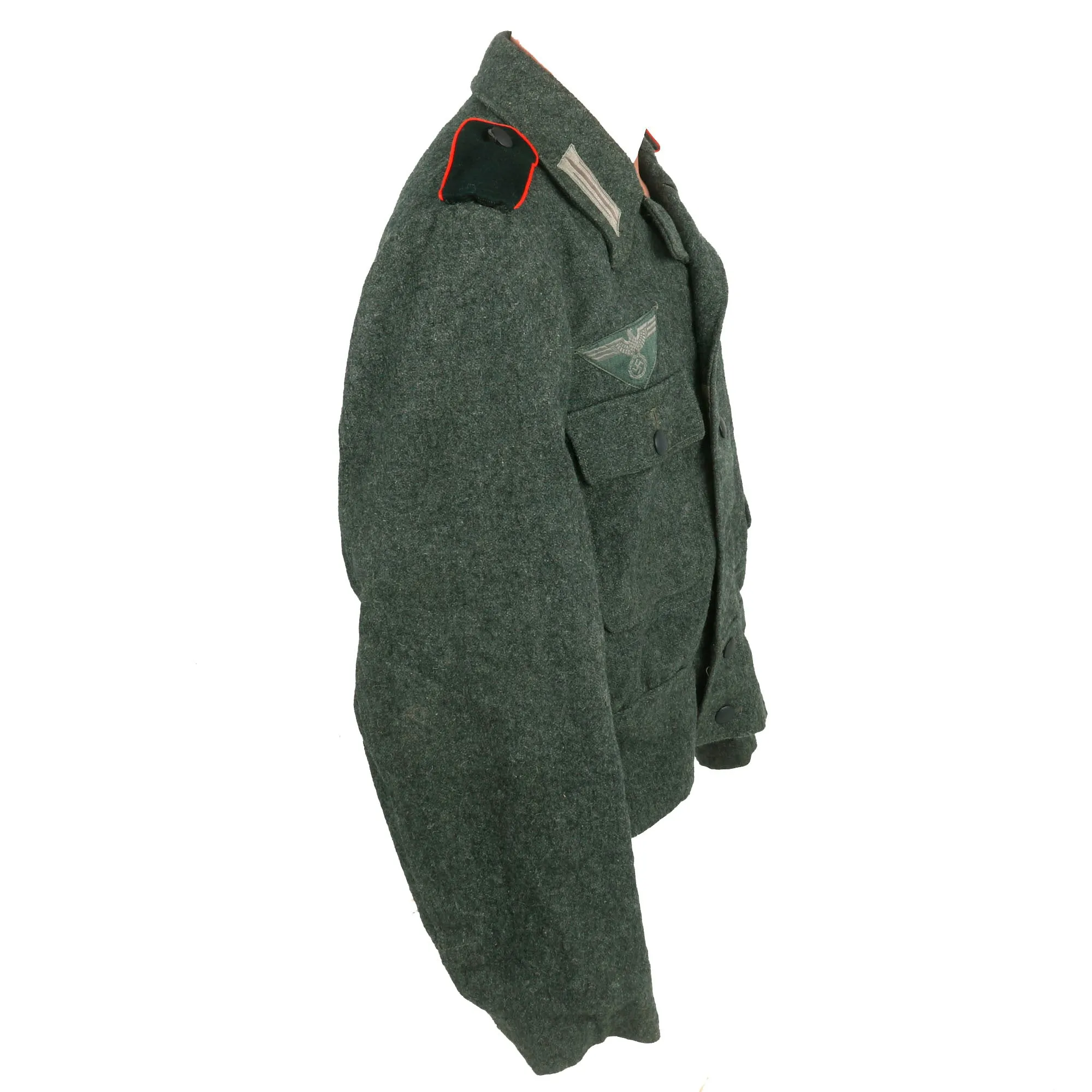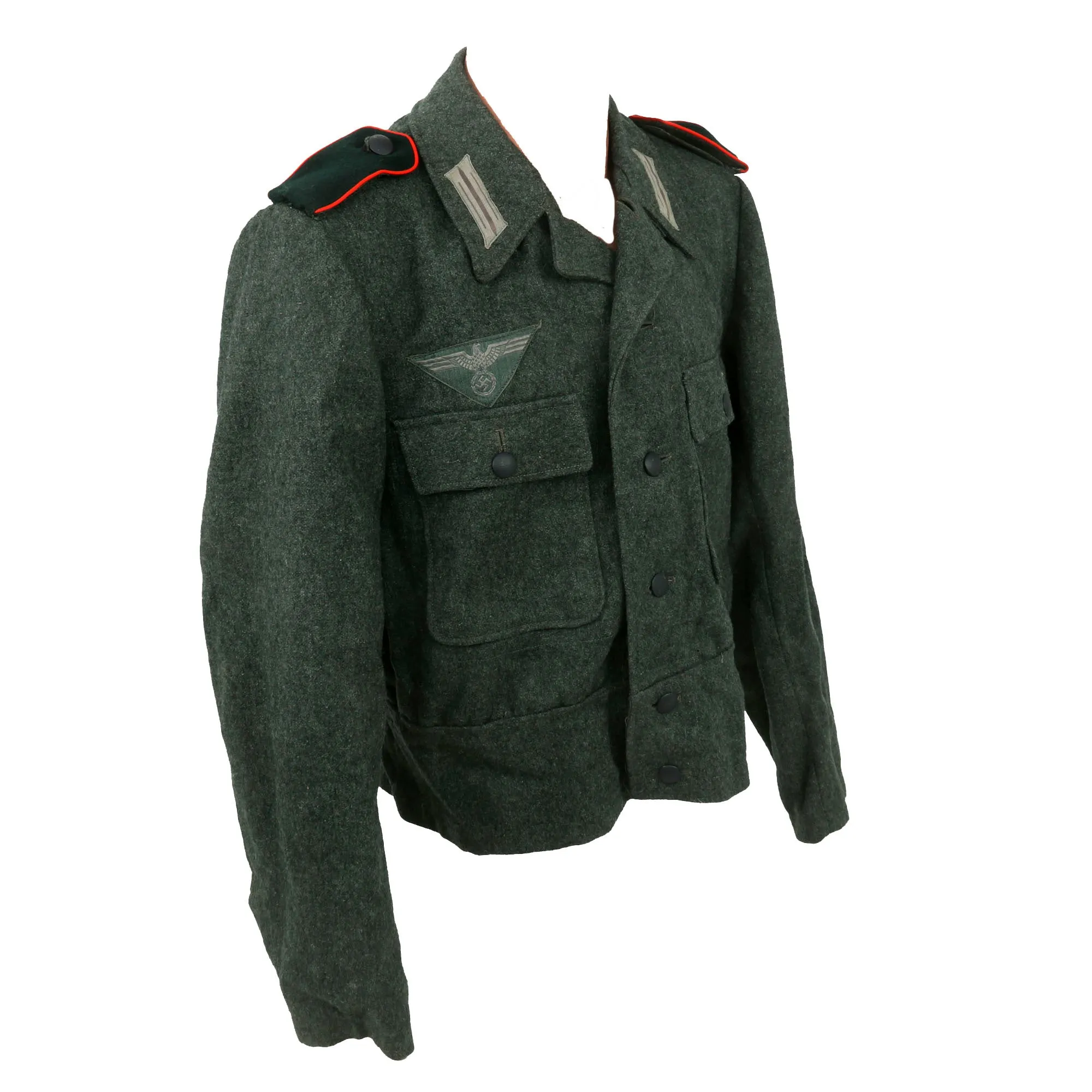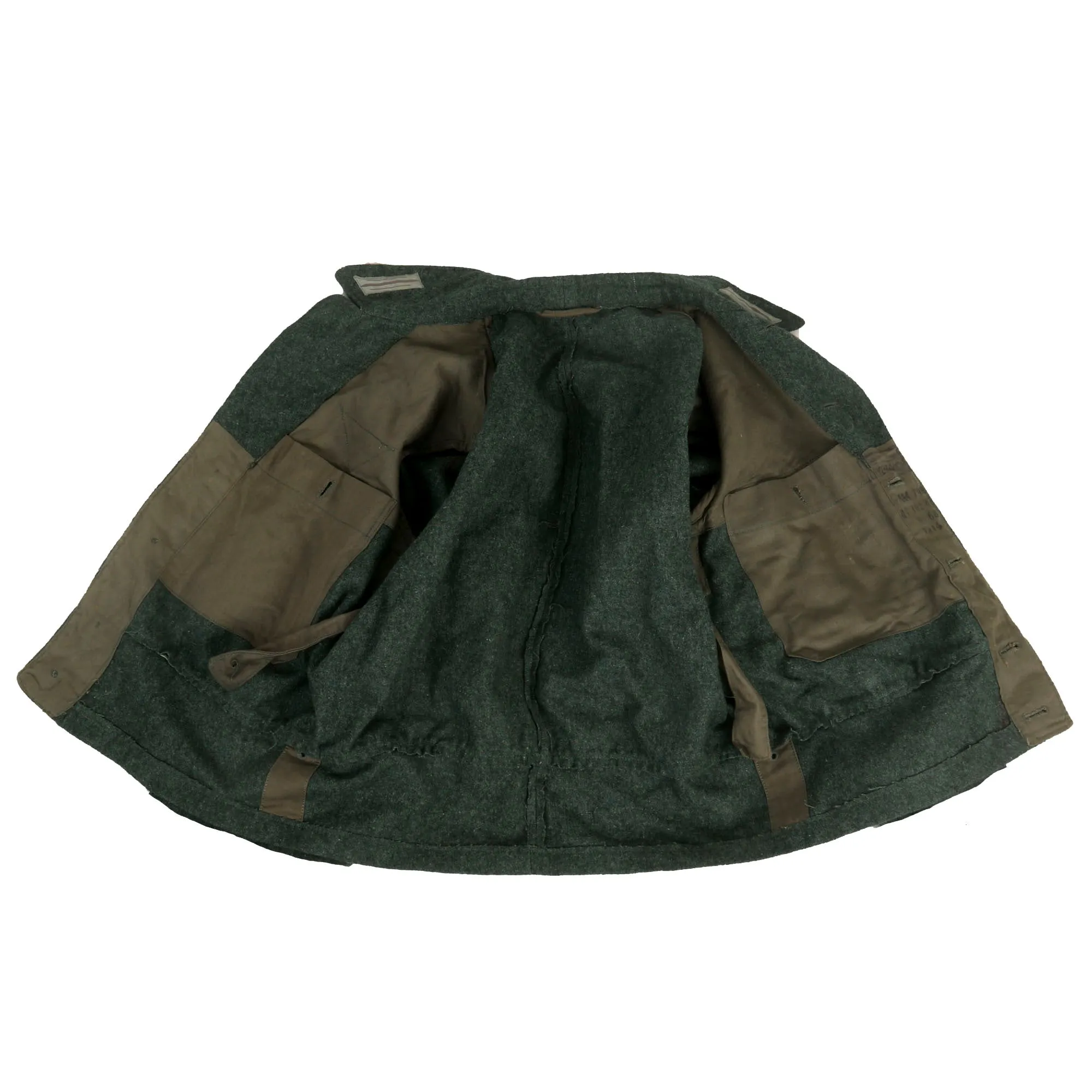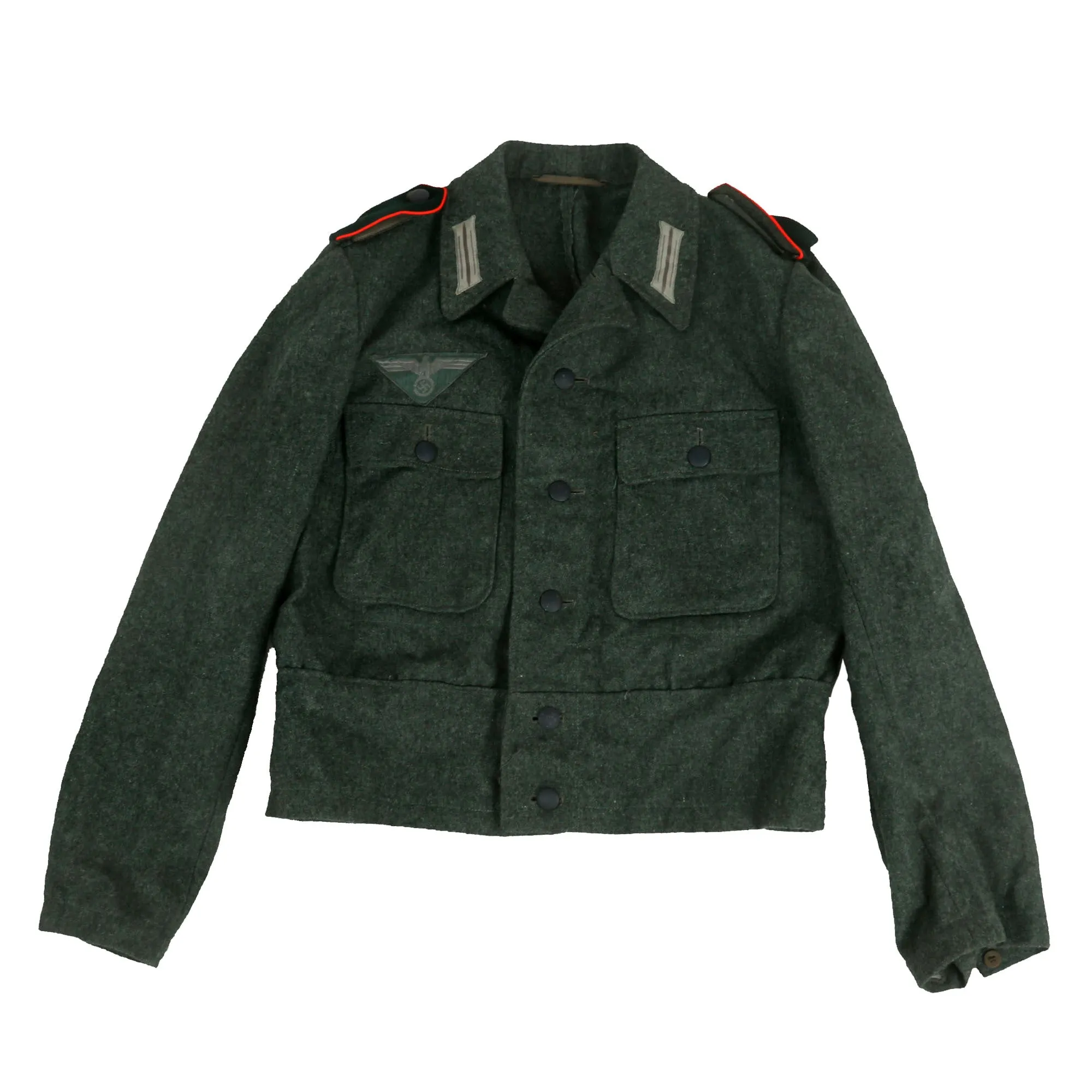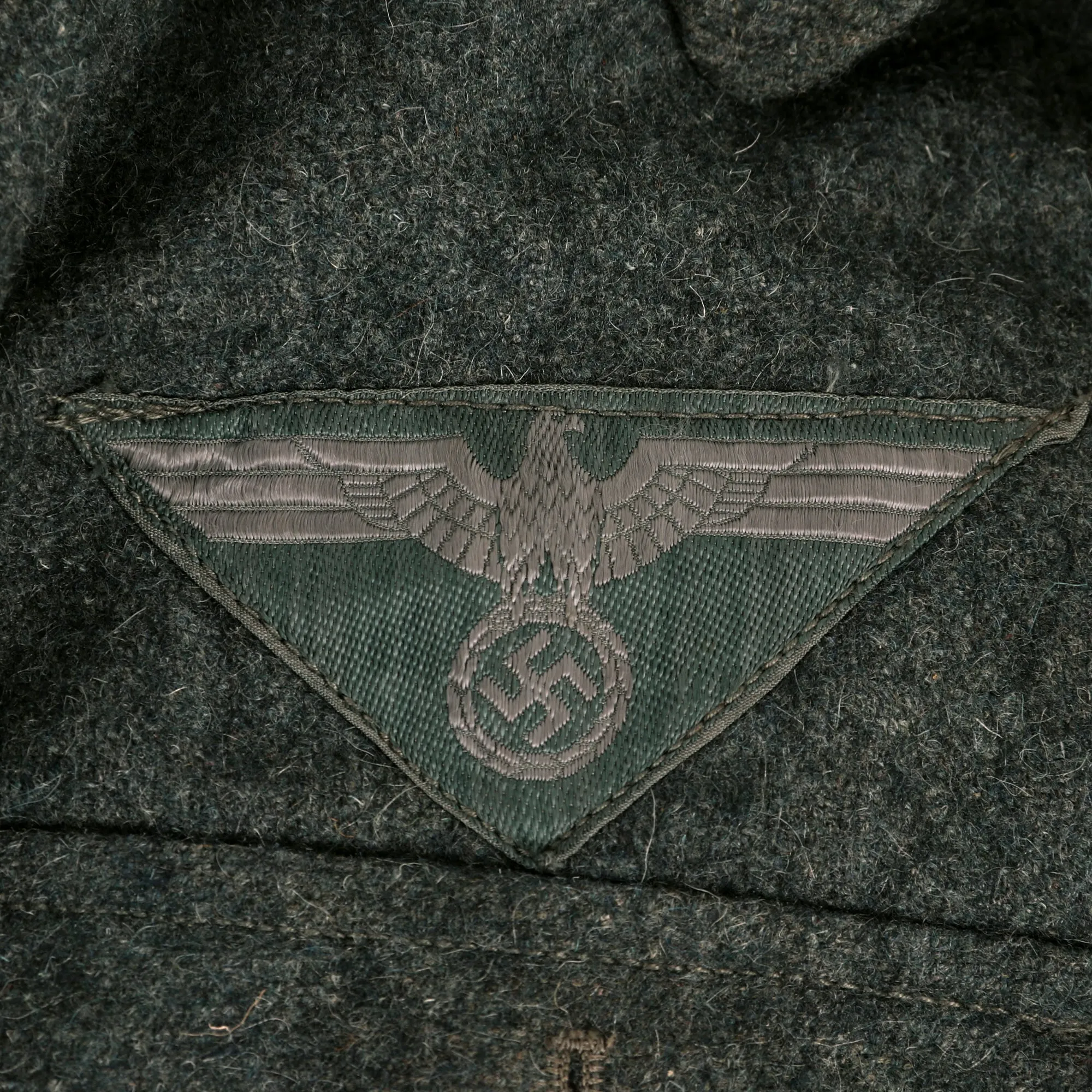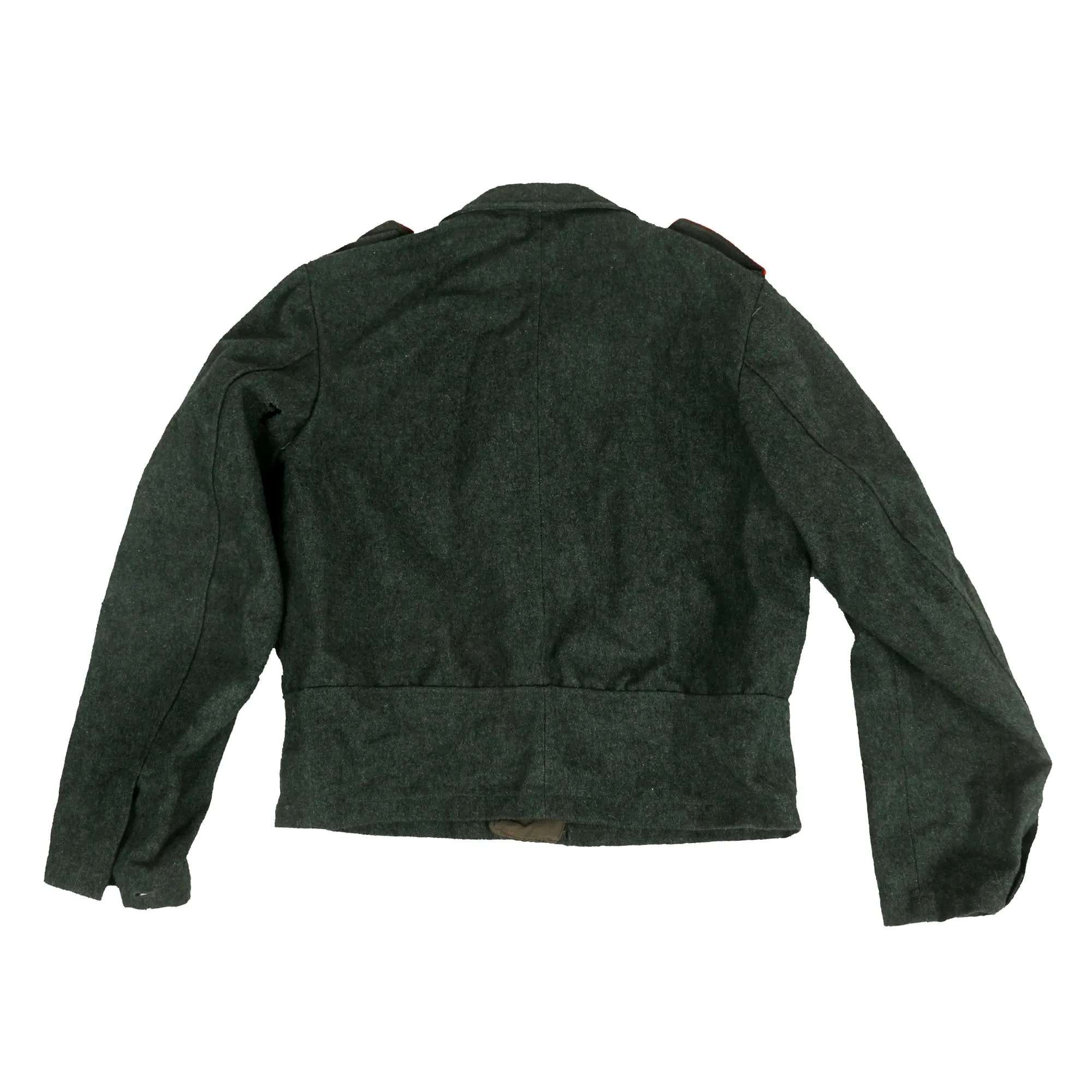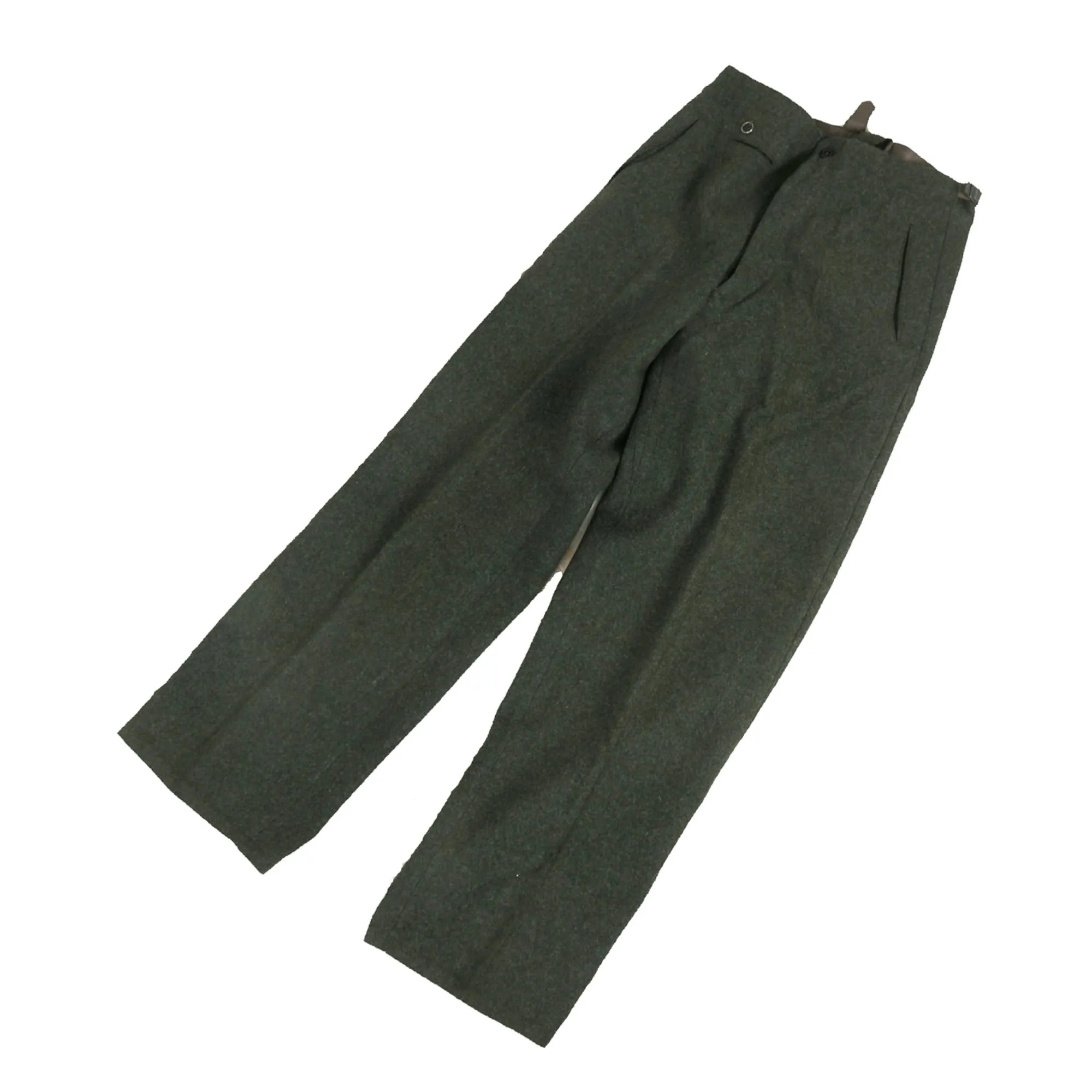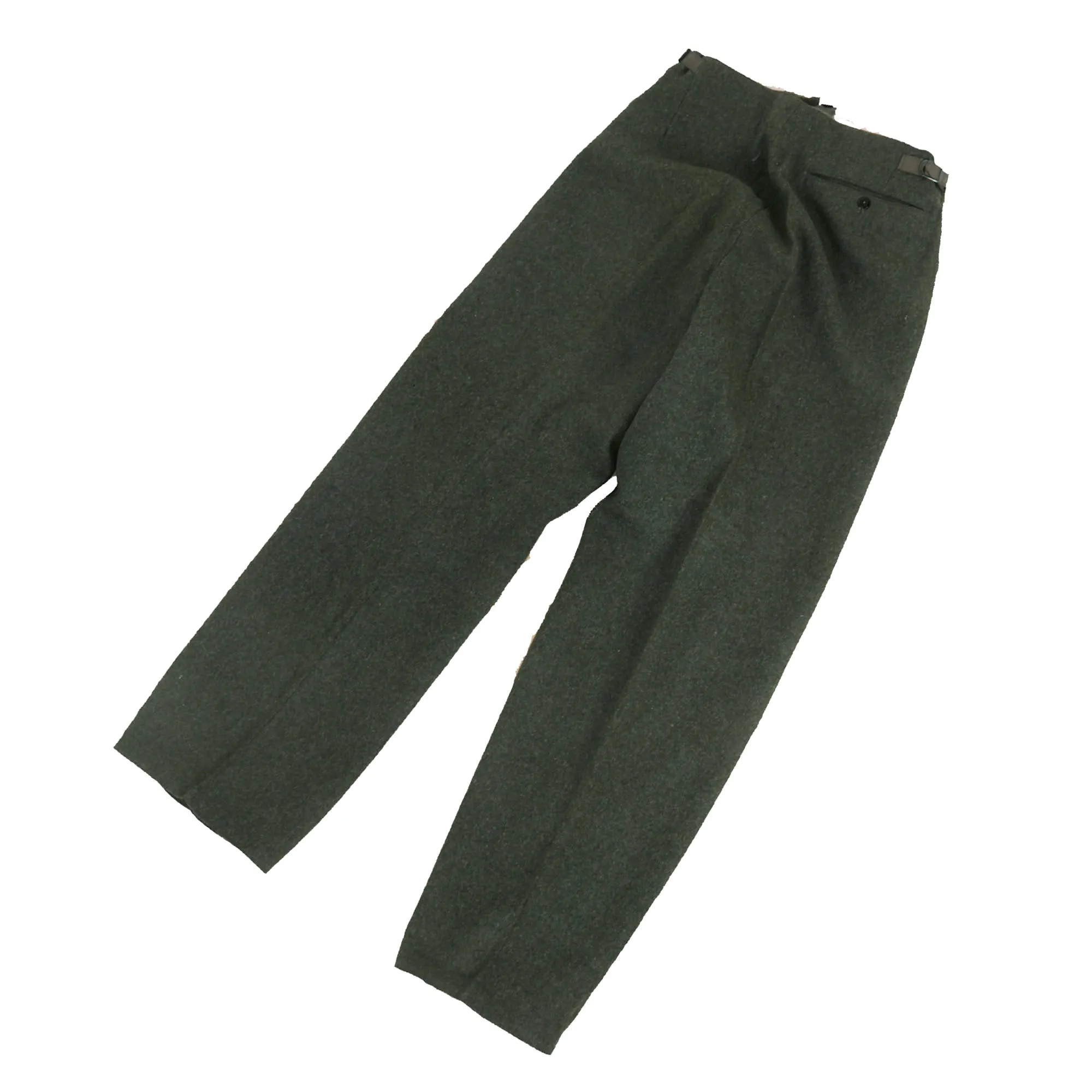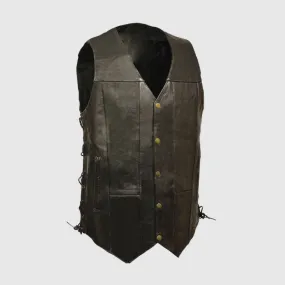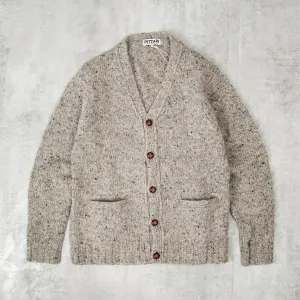Original Item: Only One Available. Towards the end of the Second World War in late 1944, Germany was looking to to cut down on tailoring and production costs as material shortages continued to mount. The Wehrmacht's answer to this issue was the introduction of the M44 pattern uniform. Similar in appearance to the British Battle Dress or the related US “Ike” jacket, the M44 was unlike any other German pattern uniform, and the first major deviation in uniform design since 1936. The front still featured the button front closure, but the the tunic skirt was shortened to waist length, the number of pockets was reduced to two. The tunic could be worn with an open or closed collar.
Some versions also had additional internal pockets as well as an internal belt, but on later examples these were often omitted. Additionally, the rarely used and complicated internal suspension system used on earlier designs was finally dropped. The color was the new Feldgrau 44, a drab greenish-brown. The standard German insignia would still be worn, such as the breast eagle, collar tabs (litzen), and shoulder straps. Except for the elite Panzer-Lehr-Division, which field-tested the new uniform in summer 1944 before its approval for general issue, the M44 was usually seen at the front only in the war’s last months and generally on the greenest of troops. Due to rushed production, many were not even fully outfitted with all the correct insignia.
This is a lovely 1944 dated service used example of the Heer Army Issue M44 tunic, which shows some great period wear, and comes complete with a pair of standard uniform trousers. It is made of very nice "Italian Cloth" style wool, in the correct Feldgrau 44 color. It features two un-pleated chest pockets with square flaps, each secured with a green painted pebbled button. The front closure features five of the same buttons on the right breast flap meeting an equal number of reinforced buttonholes on the left flap. The buttons do all look to be maker marked, but we cannot read the stamps, and all are sewn directly to the fabric.
The interior is mostly unlined, as is correct, but it is an early version that still does have inner chest pockets on both sides, as well as internal suspension straps for belt clips. It also has complete markings on the inner left side button reinforcement, which shows an RBNr. manufacturer code as well as complete size information. This gives both the measurements of the tunic, as well as the height of the person it was intended to fit. Underneath this is a depot marking of W Br 44, indicating it was processed through the Wien - Brünn (Vienna - Brno) depot in 1944. Research indicates that the RBNr. code is for maker Hanisch & Co. of Prossnitz, the German name for Prostějov in occupied Czechoslovakia. This maker would have definitely had items processed through the Vienna-Brno depot.
The tunic is fitted with the correct insignia, including late war enlisted gray BeVo style litzen on the collar, and a green / gray triangular BeVO machine embroidered breast eagle, totally correct for this type of tunic. We cannot see any signs that other insignia were sewn onto the tunic, which was fairly typical for examples made late in the war.
The tunic does however have a set of large WWI style Mannschaften Schulterklappen (Enlisted Shoulder straps), which are a flaschengrün (dark bottle-green) color with hochrot (deep red) piping around the edges. While one might assume these are for artillery, these are actually the style and size used for foreign volunteers later in the war. With these, the color of the piping indicated where they were from, and the deep red color were for Cossack volunteers, which were mostly from the Don Cossack group. Turkish volunteers had light blue piping, while volunteers from Azerbaidjan were green.
Condition shows long use in the field, with loss of the fuzzy "nap" on the fabric in many areas, as well as a hole on the upper rear left sleeve. This looks to be from a tear, but there also is a bit of mothing as well. The stitching is all still sound, and the buttons are attacked well. It has that great "service worn" look that is impossible to duplicate.
The included trousers are an earlier version, and are fairly standard, being in very good condition. Foreign volunteers were very often given mismatched uniforms to wear, as well as those that had a lot of wear already.
A very interesting German WWII uniform with some great Don Cossack foreign volunteer shoulder insignia. Ready to research and display!
Approximate Measurements:
Cossacks
The Cossacks are a predominantly East Slavic Orthodox Christian people group originating in the steppes of Eastern Europe. They were a semi-nomadic and semi-militarized people, who, while under the nominal suzerainty of various Eastern European states at the time, such as the Russian Empire or the Polish–Lithuanian Commonwealth, were allowed a great degree of self-governance in exchange for military service. The Cossacks were particularly noted for holding democratic traditions.
They inhabited sparsely populated areas in the Dnieper, Don, Terek, and Ural river basins, and played an important role in the historical and cultural development of both Ukraine and Russia. The various Cossack groups were organized along military lines, with large autonomous groups called hosts. Each host had a territory consisting of affiliated villages called stanitsa. The Cossack way of life persisted into the twentieth century, though the sweeping societal changes of the Russian Revolution disrupted Cossack society as much as any other part of Russia; many Cossacks migrated to other parts of Europe following the establishment of the Soviet Union, while others remained and assimilated into the Communist state. Cohesive Cossack-based units were organized and fought for both Germany and the Soviet Union during World War II.
Don Cossacks
Don Cossacks or Donians, are Cossacks who settled along the middle and lower Don. Historically, they have been located within what was the Don Cossack Host, which was either an independent or an autonomous democratic republic in the present-day Southern Russia and the Donbas region of Ukraine, from the end of the 16th century until 1918. As of 1992, by the presidential decree of the Russian Federation, Cossacks can be enrolled on a special register. A number of Cossack communities have been reconstituted to further the Cossack cultural traditions, including those of the Don Cossack Host.
Don Cossacks have had a rich military tradition, playing an important part in the historical development of the Russian Empire and participating in most of its major wars.
Don Cossacks in World War II
On 20 April 1936 the previous ban on Cossacks serving in the Red Army was lifted. Later the same year two existing Red Army cavalry divisions were re-designated as Don Cossacks. By 1939 a number of these regiments had been issued with traditional Cossack uniforms in ceremonial and field service versions. The dress of the Don Cossack units included the broad red stripes on dark-blue breeches, which had been their distinguishing feature prior to the Revolution. The Don Cossack Cavalry Corps saw extensive active service until 1943, after which its role diminished (as did that of the other remaining horse-mounted units in the Red Army). However Don Cossack cavalry was still in existence in 1945 and participated in the Victory Parade in Moscow.
During World War II, the Don Cossacks mustered the largest single concentration of Cossacks within the German Army, the XVth SS Cossack Cavalry Corps. A great part of the Cossacks were former Russian citizens who elected to fight not so much for Germany as against the Soviet Union. The XVth SS Cossack Cavalry Corps included the 1st Cossack Division and the 2nd Cossack Division. The majority of the Cossacks remained loyal to the Red Army. In the earliest battles, particularly the encirclement of Belostok Cossack units such as the 94th Beloglisnky, 152nd Rostovsky and 48th Belorechensky regiments fought to their death.
In the opening phase of the war, during the German advance towards Moscow, Cossacks became extensively used for the raids behind enemy lines. The most famous of these took place during the Battle of Smolensk under the command of Lev Dovator, whose 3rd Cavalry Corps consisted of the 50th and 53rd Cavalry divisions from the Kuban and Terek Cossacks, which were mobilized from the Northern Caucasus. The raid, which in ten days covered 300 km and destroyed the hinterlands of the 9th German Army, before successfully breaking out. Whilst units under the command of General Pavel Belov, the 2nd Cavalry Corps made from Don, Kuban and Stavropol Cossacks spearheaded the counter-attack onto the right flank of the 6th German Army delaying its advance towards Moscow.
The high professionalism that the Cossacks under Dovator and Belov (both generals would later be granted the title Hero of the Soviet Union and their units raised to a Guards (elite) status) ensured that many new units would be formed. In the end, the Germans during the whole war only managed to form two Cossack Corps, while the Red Army in 1942 alone had 17. Many of the newly formed units were filled with ethnically Cossack volunteers. The Kuban Cossacks were allocated to the 10th, 12th and 13th Corps. However, the most famous Kuban Cossack unit would be the 17th Cossack Corps under the command of general Nikolay Kirichenko.
During one particular attack, Cossacks destroyed up to 1,800 enemy soldiers and officers, they took 300 prisoners, seized 18 artillery pieces and 25 mortars. The 5th and 9th Romanian Cavalry divisions fled in panic, and the 198th German Infantry division, carrying large losses, hastily departed to the left bank of the river Ei.
During the opening phase of the Battle of Stalingrad, when the Germans overran the Kuban, the majority of the Cossack population, long before the Germans began their agitation with Krasnov and Shkuro, became involved in Partisan activity. Raids onto the German positions from the Caucasus mountains became commonplace. After the German defeat at Stalingrad, the 4th Guards Kuban Cossack Corps, strengthened by tanks and artillery, broke through the German lines and liberated Mineralnye Vody, and Stavropol.




